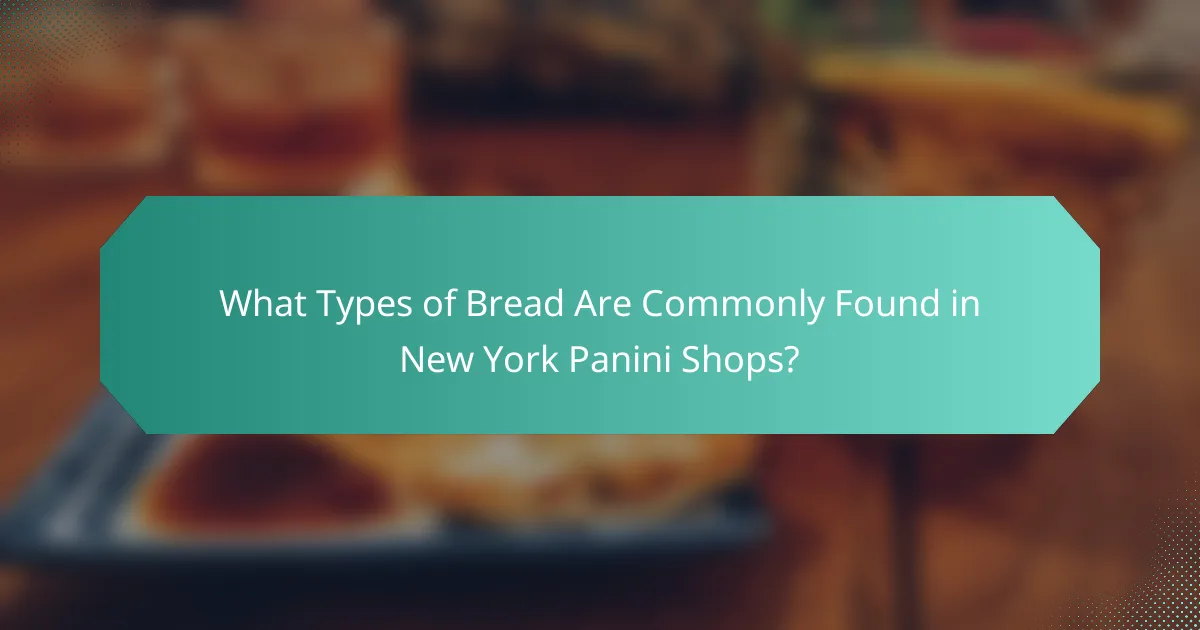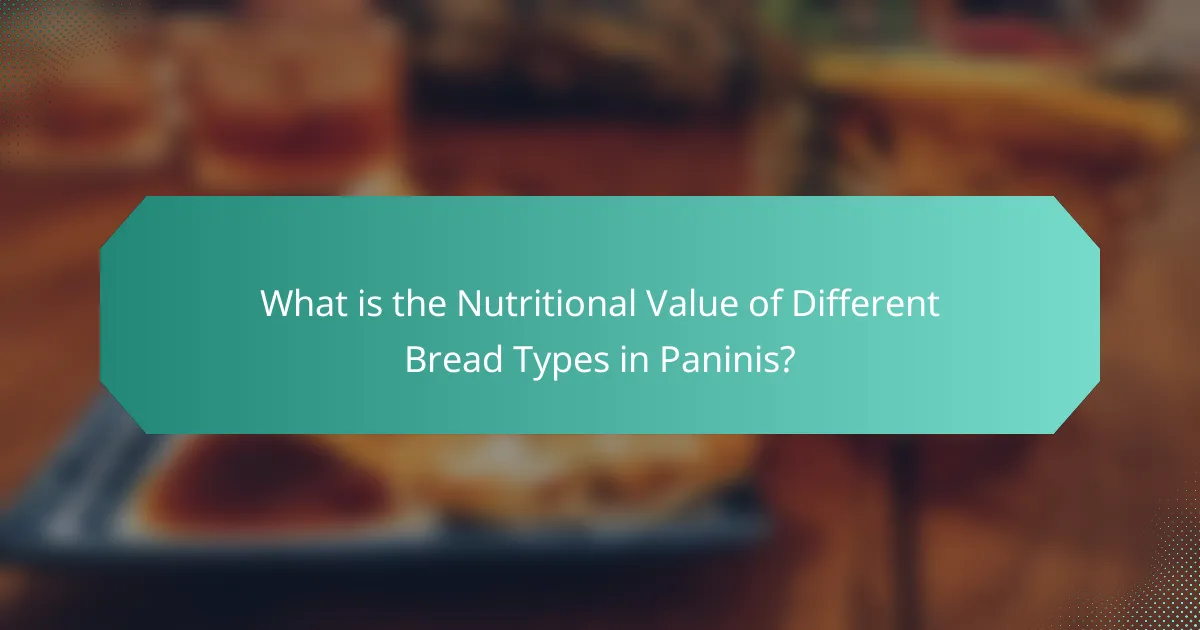
What Types of Bread Are Commonly Found in New York Panini Shops?
Ciabatta, focaccia, and baguette are commonly found in New York panini shops. Ciabatta is known for its rustic texture and airy crumb. Focaccia is often seasoned with olive oil and herbs, providing a flavorful option. Baguette offers a crispy crust and chewy interior, making it a popular choice. These breads are favored for their ability to hold fillings without becoming soggy. Many panini shops source these breads from local bakeries, ensuring freshness. The variety caters to diverse tastes and preferences among customers.
How do the types of bread influence the overall panini experience?
The types of bread significantly influence the overall panini experience. Different breads offer varying textures, flavors, and structural integrity. For instance, ciabatta has a light, airy texture that allows for crispy exteriors and soft interiors when grilled. Sourdough provides a tangy flavor and dense texture, enhancing the taste profile of the panini. Whole grain breads add nutritional value and a nutty flavor, appealing to health-conscious consumers. Additionally, the choice of bread affects how well the panini holds its fillings. Sturdier breads prevent sogginess, ensuring a more enjoyable eating experience. The toasting process also varies with bread types, impacting the final taste and texture. Overall, bread selection is crucial in defining the quality and enjoyment of a panini.
What are the characteristics of ciabatta bread in paninis?
Ciabatta bread in paninis is known for its rustic crust and airy, open crumb structure. The crust is typically crispy and chewy, providing a satisfying texture. Inside, the bread is light and has large holes, which helps it absorb sauces and fillings without becoming soggy. Ciabatta also has a slightly nutty flavor due to its high hydration and use of olive oil. This bread is versatile, pairing well with various ingredients, from meats to vegetables. Its unique texture and flavor enhance the overall panini experience, making it a popular choice in New York panini shops.
Why is focaccia a popular choice for panini sandwiches?
Focaccia is a popular choice for panini sandwiches due to its unique texture and flavor profile. This Italian bread is characterized by its soft, airy interior and a crispy crust. The high oil content in focaccia enhances its richness, making it an excellent pairing for various fillings. Its ability to hold moisture well prevents sogginess, which is crucial for panini. Additionally, focaccia can be easily infused with herbs and toppings, adding depth to the sandwich experience. Many chefs prefer focaccia for its versatility in flavor combinations. Its popularity is also supported by the growing trend of artisan breads in New York panini shops.
What makes sourdough bread unique for panini preparation?
Sourdough bread is unique for panini preparation due to its distinct tangy flavor and chewy texture. The natural fermentation process creates a complex taste profile that enhances the overall sandwich experience. Its crust is typically thicker and crunchier, providing a satisfying contrast to the soft interior. This texture holds up well to grilling, preventing sogginess when filled with moist ingredients. Additionally, sourdough’s lower pH can inhibit mold growth, extending shelf life. The presence of beneficial bacteria and yeasts contributes to its digestibility and nutritional value. Studies show that sourdough fermentation increases the availability of nutrients, making it a healthier choice for panini.
What are the regional variations in bread selection across New York’s panini shops?
Regional variations in bread selection across New York’s panini shops include diverse options like ciabatta, focaccia, and baguettes. Shops in Italian neighborhoods often favor ciabatta for its airy texture. In contrast, those in French districts may prefer baguettes for their crusty exterior. Some establishments offer whole grain and gluten-free options to cater to health-conscious consumers. Each neighborhood’s cultural influences shape these preferences. For instance, artisanal bakeries contribute unique bread types, enhancing local panini offerings. Seasonal ingredients also affect bread choices, with some shops featuring specialty breads during holidays. This variety reflects New York’s multicultural food scene.
How do Italian bakeries differ from artisanal shops in their bread offerings?
Italian bakeries typically offer a wide variety of traditional bread types, such as ciabatta and focaccia. These breads are often made using regional recipes and methods passed down through generations. The focus is on authentic flavors and textures that reflect Italian heritage.
Artisanal shops, on the other hand, emphasize unique and innovative bread creations. They often experiment with different grains and flavors, catering to modern dietary preferences. Artisanal bread may include sourdoughs, whole grain options, and specialty loaves that highlight seasonal ingredients.
The difference lies in the approach to bread-making. Italian bakeries prioritize traditional techniques, while artisanal shops often embrace creativity and experimentation. This results in distinct offerings that cater to different consumer preferences.
What influences the bread choices in different neighborhoods?
Bread choices in different neighborhoods are influenced by cultural preferences, local demographics, and economic factors. Cultural preferences dictate the types of bread popular in various communities. For instance, neighborhoods with a high Italian population may favor ciabatta and focaccia. Local demographics also play a role in determining bread choices. Areas with diverse populations may offer a variety of bread types to cater to different tastes. Economic factors, such as income levels, affect the availability and affordability of certain breads. Neighborhoods with higher income levels may have access to artisanal and specialty breads. Additionally, the presence of local bakeries can shape bread choices. Bakeries often reflect the tastes and preferences of the surrounding community. Overall, these influences create a unique bread selection in each neighborhood.

What Textures Should You Expect from Bread in Panini Shops?
In panini shops, you should expect a variety of textures from the bread. Common textures include crispy crusts and soft interiors. The outer crust is often toasted to achieve a crunchy feel. This contrast enhances the overall eating experience. Many panini breads are made from ciabatta, focaccia, or sourdough. These types contribute to unique textural profiles. For instance, ciabatta is known for its airy structure. Focaccia tends to be more dense and chewy. Sourdough offers a tangy flavor with a crusty exterior. Each type of bread is selected to complement the fillings used in paninis. Overall, the textures of bread in panini shops are designed to provide a satisfying bite.
How does the texture of bread affect the taste and enjoyment of a panini?
The texture of bread significantly impacts the taste and enjoyment of a panini. A crusty exterior provides a satisfying crunch, enhancing the overall sensory experience. This contrast between the crispy crust and the soft interior creates a pleasurable mouthfeel. Additionally, the texture influences how well the bread holds fillings without becoming soggy. A denser bread can provide better structural integrity, allowing for more robust toppings. Studies show that texture can affect flavor perception, making the panini more enjoyable. For instance, a chewy texture can prolong the tasting experience, allowing flavors to develop fully. Overall, the right texture complements and elevates the flavors within a panini.
What role does crustiness play in the overall panini texture?
Crustiness significantly contributes to the overall texture of a panini. A crusty exterior provides a satisfying crunch when bitten into. This contrast enhances the sensory experience of the sandwich. Additionally, the crust helps to seal in moisture from the fillings. This moisture retention prevents the bread from becoming soggy. Studies show that a well-toasted crust can improve flavor perception. The Maillard reaction during toasting creates complex flavors. Therefore, crustiness is essential for both texture and taste in a panini.
How does the softness of the bread impact the filling’s flavor?
The softness of the bread can enhance or diminish the filling’s flavor. Soft bread allows the filling’s moisture and flavor to be more prominent. It creates a contrast that can make the filling taste richer and more vibrant. For example, a soft ciabatta may absorb juices from a savory filling, intensifying the overall taste experience. Additionally, the texture of soft bread can create a more enjoyable mouthfeel, making flavors more appealing. Studies suggest that texture influences taste perception, indicating that softer bread can improve flavor enjoyment.
What are the best practices for achieving the ideal texture in panini bread?
To achieve the ideal texture in panini bread, use high-protein flour. High-protein flour contributes to a chewier texture. Hydration levels should be around 65-75% for optimal moisture balance. Kneading the dough adequately develops gluten structure, enhancing texture. Allow the dough to rise until it doubles in size for proper aeration. Using a hot press ensures a crispy crust while maintaining a soft interior. Baking on a stone or steel can improve heat retention, leading to better texture. Finally, resting the bread after baking allows for moisture redistribution, resulting in a more balanced texture.
How does the grilling process affect the bread’s texture?
The grilling process creates a crispy outer crust on the bread. This occurs due to the Maillard reaction, which enhances flavor and texture. The heat causes moisture to evaporate, leading to a firmer exterior. Inside, the bread remains soft and chewy. Grilling also caramelizes sugars, contributing to a richer taste. The contrast between the crunchy crust and tender interior is desirable in paninis. Studies show that proper grilling can improve overall texture satisfaction.
What techniques can enhance the bread’s crispiness?
To enhance bread’s crispiness, use techniques such as baking at high temperatures. A temperature range of 425°F to 475°F is ideal for achieving a crispy crust. Additionally, using steam during the initial baking phase can create a better crust. This technique allows moisture to escape, which contributes to crispiness. Another method is to preheat the baking surface, such as a pizza stone. This ensures even heat distribution and promotes a crispy bottom. Lastly, allowing the bread to cool on a wire rack prevents moisture accumulation, maintaining crispiness. Each of these techniques is backed by baking science, emphasizing temperature and moisture management for optimal crust texture.

What is the Nutritional Value of Different Bread Types in Paninis?
The nutritional value of different bread types in paninis varies significantly. Common bread types include ciabatta, focaccia, and whole grain. Ciabatta typically contains about 200 calories per 100 grams. It has around 8 grams of protein and 1 gram of fiber. Focaccia is slightly higher in calories, averaging 250 calories per 100 grams, with about 6 grams of protein and 2 grams of fiber. Whole grain bread is often the healthiest option. It usually contains 250 calories per 100 grams, 12 grams of protein, and 7 grams of fiber. These values illustrate the differences in nutritional content among various bread types used in paninis.
How does the nutritional profile vary between different types of bread?
Different types of bread have distinct nutritional profiles. Whole grain bread typically contains more fiber and nutrients compared to white bread. For instance, whole grain bread can have up to 3-5 grams of fiber per slice. White bread, on the other hand, often has less than 1 gram of fiber. Rye bread is known for its lower glycemic index, which can aid in blood sugar management. Sourdough bread may have probiotics due to fermentation, contributing to gut health. Gluten-free bread alternatives often contain different flours like almond or rice, leading to variations in protein and carbohydrate content. Each type of bread serves different dietary needs and preferences, affecting overall nutrition.
What are the health benefits of whole grain bread in paninis?
Whole grain bread in paninis offers several health benefits. It is rich in dietary fiber, which aids digestion and promotes a feeling of fullness. Whole grain bread contains essential nutrients such as B vitamins, iron, magnesium, and antioxidants. These nutrients support energy metabolism and overall health. Additionally, whole grains have been linked to a lower risk of heart disease and type 2 diabetes. Research shows that consuming whole grains can help maintain healthy cholesterol levels. The fiber content also helps regulate blood sugar levels, making it a healthier choice for those with insulin sensitivity. Overall, incorporating whole grain bread in paninis enhances their nutritional value significantly.
How does white bread compare nutritionally to multigrain options?
White bread generally has lower nutritional value compared to multigrain options. White bread is made from refined flour, which removes fiber and nutrients. In contrast, multigrain bread includes various whole grains, providing more fiber, vitamins, and minerals. For example, multigrain bread can contain oats, barley, and millet, which contribute to a higher fiber content. Studies indicate that multigrain bread can have up to 3-5 grams of fiber per slice, while white bread typically has less than 1 gram. Additionally, multigrain options often have a lower glycemic index, promoting better blood sugar control. These factors make multigrain bread a healthier choice for those seeking balanced nutrition.
What should consumers consider regarding bread nutrition when choosing a panini?
Consumers should consider the type of bread used in a panini for its nutritional value. Whole grain bread offers more fiber and nutrients compared to white bread. Fiber aids digestion and promotes satiety. Additionally, the calorie content varies between bread types. For example, ciabatta may have higher calories than whole wheat. Consumers should also check for added sugars and preservatives in the ingredient list. These additives can negatively impact health. Finally, portion size matters; larger bread may lead to higher caloric intake.
How can dietary restrictions affect bread selection in panini shops?
Dietary restrictions significantly influence bread selection in panini shops. Customers with gluten intolerance often seek gluten-free bread options. This demand has led many shops to offer alternatives like rice flour or almond flour bread. Similarly, those following vegan diets avoid bread with dairy or egg ingredients. As a result, shops may provide vegan-friendly bread made from plant-based ingredients. Additionally, health-conscious consumers may prefer whole grain or low-carb options. These preferences shape the variety of bread available in panini shops. Shops that cater to dietary restrictions typically attract a broader customer base. This responsiveness to dietary needs enhances customer satisfaction and loyalty.
What tips can help you make healthier bread choices for your panini?
Choose whole grain or whole wheat bread for your panini. Whole grain options contain more fiber and nutrients. Look for breads with minimal added sugars. Breads with high sugar content can lead to unhealthy spikes in blood sugar. Select options with seeds or nuts for added protein and healthy fats. These ingredients enhance the nutritional profile of your panini. Avoid white bread or products made with refined flour. Refined flour lacks essential nutrients and fiber. Check the ingredient list for whole grains as the first ingredient. This ensures that the bread is primarily made from healthier sources. Aim for breads that are low in sodium. High sodium content can contribute to health issues.
The main entity of this article is bread selection in New York panini shops, which encompasses various types, textures, and nutritional values of bread used in paninis. The article examines common bread types like ciabatta, focaccia, and sourdough, highlighting their unique attributes, flavors, and how they influence the overall panini experience. It also discusses the impact of texture on taste, the nutritional profiles of different breads, and the factors that shape bread choices in various neighborhoods. Additionally, the article addresses dietary restrictions and provides tips for making healthier bread selections for paninis.